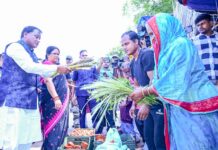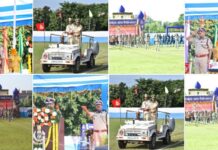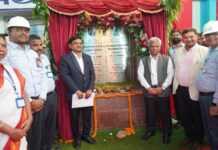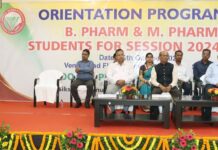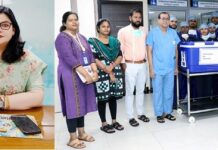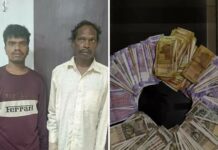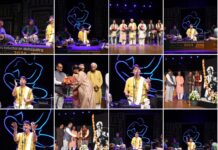By Anurjay Dhal
BHUBANESWAR: Old timers having close proximity with Royal families in Aul-Rajkanika in Odisha’s coastal pockets of Kendrapara says, late Raja Saheb Sarat Deb of Aul Royal palace, if alive today and Rajamata Sushree Devi active in politics, they would have stopped water being lifted from River Kharasrota for use of others but the way junior Deb read, BJD’s All-in-One in Aul Assembly segment in Odisha, Pratap Keshari Deb, who now in his 4th term from this seat in State Assembly, including a Cabinet berth and Rajya Sabha nomination, seems paying no heads to what his late father Raja Saheb’s dreams for his Karmabhoomi, Aul-Kanika.
“Right from his nomination to State Assembly way back in 1971 for 4 terms as candidate of Swatantra Party and Janata Dal and winning the 5th, 6th, 7th and 8th Assembly polls till his death in 1989, as Kendrapara Lok Sabha MP, Sarat Deb was Sarat Deb and never compromised for anything if that was detrimental to the interest of Aul-Kanika but what his younger son doing while advocating for water to be lifted for Bhadrak from River Kharasrota, which is flowing just backside of BJD MLA’s Aul Royal palace,” a Kendrapara veteran said.
An old timer said, late Raja Saheb used to spent some quality time at Gadagadi Ghat including both Bharigada side in Kanika and Balakati side in Aul after completing his days tour to his Constituency. “Raja Saheb was always worry for local farmers and farming issues and even he had planned several projects to save Aul-Kanika from floods and during the 1971 and 82 massive floods, he extensively traversed with relief materials and for Raja Saheb, many lives were saved at that time,” he said.
Pratap Deb’s ailing mother Rajamata Sushree Devi too elected to Assembly from Aul seat in 1990 and was very close to late Biju Patnaik because she actively worked for Aul-Kanika and later she was sent to Rajya Sabha, served there from 2002 to 2008 as because of close proximity between Raja Saheb and Biju Babu,” sources argued.
“When Aul-Kanika people protesting over water like issue, as local MLA, Pratap Deb should hold consultation with all stake holders instead hosting party meeting to counter to allegations of local BJP and Congress leaders like Dola Nayak and Deba Sharma,” a BJD MP said adding locals should be taken into confidence if something looks controversial.
Pratap Deb for the first time in his 20 years long political career including 4th terms in Assembly, a Rajya Sabha berth and Chairman , Housing Board , never faced such local resistance as he is facing since Naveen Patnaik led BJD Government planned 2 drinking water projects to be implemented under Vasudha Scheme in Bhadrak and Rajkanika and Aul blocks in Kendrapara with an investment of Rs 892 Crore and 268.11 Crore respectively.
“Last time, Aul-Kanika people had given a thumping victory in 2019 to Pratap Deb and were hoping best from him, but the way the BJD MLA advocating for water to be used for Bhadrak project, it has hurt sentiments of many,” admitted a BJD veteran in Rajkanika.
With locals continuing protest, both Deoranjan Kumar Singh, Principal Secretary Panchayati Raj & Drinking Water Department, and Engineer-in-Chief, RWSS, Abhaya Kumar Biswal and BJD MLA Deb, will face more tough time to implements these welfare projects, sources in Odisha Government said.
According to a report on ground water level that published in 2017 for Kendrapara’s Rajkanika, Rajnagar, Mahakalpada and Garadapur blocks, it was stated that ground water level reported salt water while ground water level in Bhadrak’s Tihidi, Basudevpur and Dhamnagar blocks were started to be safe water. If that the case, as to why Government is insisting on lifting water from Kharasrota for Bhadrak, which has 4 major rivers like Baitarani, Salandi ,Mantei and Kansabansa. As per the dynamic ground water resources assessment of India-2017, Kendrapara has 5445.19 HAM ground water while Bhadrak has 17021.48 HAM, which is 3 times more than Kendrapara but why water from Kharasrota to be used for Bhadrak, the Government should explain it. Kendrapara District Irrigation Report dated on 25.04.2016 under Pradhan Mantri Krushi Surekhya Yojana, page-74, it was stated that in 2020 demand for water in Kendrapara will be around 1.463 BCM while its water level is now stands at 996 BCM.
Water experts apprehends that the commercial coal mining and as well as iron ore mining badly hitting major rivers and its tributaries “The new proposed mining in 9 new Coal blocks that include 8 in Angul alone, will add to the water scarcity not only in Angul-Talcher belt but also a number of local streams draining into Brahmani are most likely to be lost forever into the mining areas, affecting the water availability and quality of water of Brahmani and its tributaries like Kharasrota,” said Ranjan Kumar Panda, Convenor, Odisha Water Initiative. Coal mining has serious implications on the groundwater levels, local water bodies and the ecology and it would badly hit Brahmani and Kharasrota,” Panda said. Tens of thousands of farmers depending on Brahmani and its tributaries will feel the heat, he argued.Another activist questions as to why Government insisting on River Kharasrota to supply water to Bhadrak. “Any kickback behind the scenes,” he added.
It may be noted that at about 480 kilometres (300 mi) long, the Brahmani river is the second longest river in Odisha after the Mahanadi. However, if its constituent rivers are included its length extends to about 799 kilometres (496 mi), of which 541 kilometres (336 mi) are in Odisha. It has a catchment area of about 39,033 square kilometres (15,071 sq mi) in Odisha alone. Apart from the Rengali dam, there also exists a barrage shortly before Talcher called Samal Barrage. The Jokadia and the Jenapur anicuts are the other irrigation projects on the river. Near its mouth, the river is also crossed by the Odisha Coast Canal that takes water from it.
After assuming the name of Brahmani, the river crosses the Tamra and Jharbera forests, skirting along National Highway 23. It then passes the town of Bonaigarh in Sundargarh district before being dammed at Rengali in Anugul district. A large reservoir of the same name is created as a consequence. It then flows through the towns of Talcher and Dhenkanal before splitting up into two streams. The main stream flows by the town of Jajpur Road beyond which it is crossed by National Highway 16 and the Kolkata-Chennai mainline of East Coast Railway. The branch stream called Kimiria receives the waters of the Birupa (a distributary of the Mahanadi, Kelua and Genguti before re joining the main stream at Indupur. It then flows crisscrossing through Pattamundai. The river then receives the Kharsuan aka Kharasrota, on its left bank before merging with the Baitarani, a major river, to form the Dhamra estuary.
Local Congress and BJP leaders in Rajkanika and Aul are holding street meetings, pada yatra, public meetings while local BJD Deb using his party’s women wing, hosted a public meet at Kharasrota river side on Wednesday, and claimed that Bhadrak project was accorded in 2018 and after his election in 2019, he had persuaded the Government to implement another project for his Assembly seat, which was accepted and tenders have been called for 268.11 crore project.
Local MLA Deb’s sudden u-turn using his party’s women wing to host a public meeting, has not gone well with locals and they too carrying out counter street meetings throughout the day, which was supported by 2 former MLA Deba Sharma of Congress and Dola Nayak of BJP.
The Engineer-in-Chief, RWSS, Biswal however assuring that if both projects are implemented, it will benefit people of both Kendrapara and Bhadrak. Officials however argued that water coming from Jokadia Dam to River Brahmani and Kharasrota is about 10% and 90 % respectively but Government considering in 50-50 ratio. As Kharasrota is deeper than Brahmani, it is housing more water and for Bhadrak project, Government will only use 2% of it from Kharasrota while rest 48% with people of Rajkanika and Aul.
Citing the Central Water Commission guidelines, officials in RWSS said, “as per law, water is first meant for drinking, then agriculture and last for industrial and commercial purposes but unfortunate that two projects including Rs 892 Crore for Bhadrak and Rs Rs 268.11 Crore for Rajkanika and Aul in Kendrapara were only meant for drinking water supply and purely for welfare of two coastal districts facing crisis of clean and safe water,” they added.
Local farmers in Rajkanika and Aul blocks are arguing that while preparing the project for Bhadrak, the State Government had skipped rivers Baitarani, Salandi, Mantei and Kansabansa which are major rivers in the State and instead preferred to extract water from Kharasrota, the smallest river in the State.
Locals living both sides of River Kharasrota ,feels their lifeline will be dried if water lifted for two projects. Sources also maintained that, if local resistance continues against Bhadrak project, Government may drop Rajkanika-Aul project and lift water from Jajpur side to feed people of Bhadrak. EIC RWSS Biswal, however maintained that both project are intended for welfare of people of Kendrapara and Bhadrak and all apprehensions have been addressed properly before execution of these mega drinking water projects. He also said that national level bidders have been invited for the project.
Local farmers in some 60 Panchayats of Rajkanika and Aul have been protesting over water lifting from River Kharasrota for Bhadrak district and they feared their agricultural activities will hit due to shortage of water. The farmers agitation more or less been carried by local Congress and BJP leaders. “This clearly overlooked the fact that the project could adversely impact the people of Rajakanika and Aul blocks in the Kendrapara district who are dependent upon their drinking and agricultural requirements from river Kharasrota” a NGT order said. The project would also adversely affect the entire Bhitarakanika National Park as it is dependent for its survival on this river which is the only source of fresh water as the other rivers are saline in nature, locals alleged.


